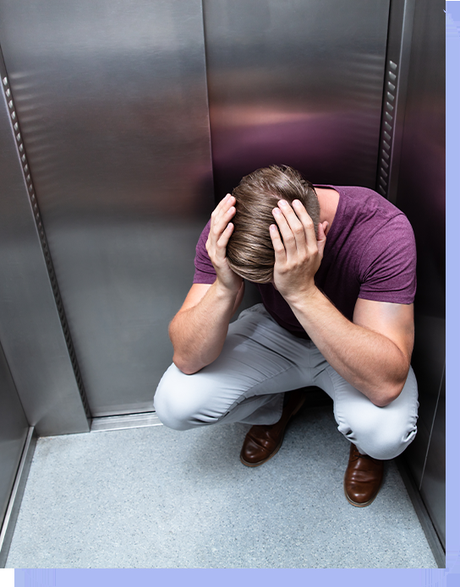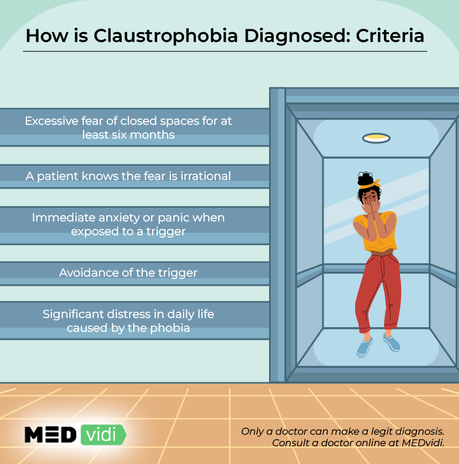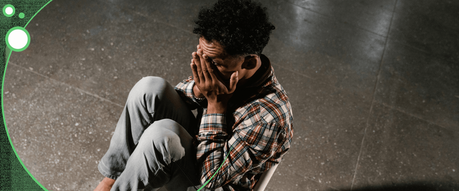Symptoms and Treatment
- 14 December, 22
 Phobias
Claustrophobia: Symptoms and Treatment
Phobias
Claustrophobia: Symptoms and Treatment
Around 12.5% of the population suffers from some form of claustrophobia, which is more common in females. If you have ever felt intensely anxious or fearful in a lift, tunnel, tube train, MRI imaging machine, windowless room, or crowded space, you may have this anxiety disorder. Not to worry, however, as you can overcome your fear of crowded or tight spaces with various therapies.
In this post, we’ll review the main features of claustrophobia, its causes, diagnostic criteria, and treatment options.
MEDvidi doctors are here to help you overcome your phobia. Contact us today to get personalized treatment.
See A Therapist OnlineWhat Is Claustrophobia
Claustrophobia is an intense and irrational fear of small spaces. The phobia is unreasonable because a person experiencing it will panic even when there is no real danger, such as when riding an elevator.
Many people with this disorder avoid situations and confined spaces that trigger their anxiety, like the car wash, subway, and public toilets. For example, you may take the stairs up many floors despite the availability of elevators. Other small spaces that may trigger anxiety include:
- Store changing rooms
- Airplanes
- Revolving doors
- Cars
- Crowded highways
- Cellars and basements
- Small and locked rooms
Some people report claustrophobic symptoms when they are in all kinds of confined spaces, while others only experience severe anxiety when in certain cramped situations like the MRI machine.
Your claustrophobia may disappear on its own, or you may require therapy to cope with the fear of tight spaces. Although claustrophobia symptoms may be severe, many people don’t seek treatment.
Claustrophobia Symptoms
Claustrophobia manifests differently for everyone. Some people experience mild anxiety when in tight spaces, while others have intense panic attacks. Common physical symptoms include:
- Trembling
- Sweating
- Rapid heartbeat
- Dizziness
- Dry mouth
- Confusion
- Hot flashes or chills
- A sensation of butterflies in the stomach
- Ringing in your ears
- Headache
- A sensation of choking
- An inability to move
- Nausea
- A need to go to the toilet
Being in an enclosed space may also trigger psychological symptoms like:
- Fear of being trapped
- Fear of dying
- Feelings of dread
- Feeling an intense urge to leave the situation
- Fear of fainting
- Fear of harm
- Realizing that the fear is irrational but being unable to stop it
You may notice that you compulsively look for exits and plan an escape in every room you enter. If you are at a crowded party, you are likely to stay near the door or fear that the door will shut and you will be unable to leave. Most people with claustrophobia also experience general anxiety and are likely to struggle with other phobias.
Anxiety and phobias may interfere with your social, professional, and academic life. Get help to improve your emotional well-being.
Get Help OnlineCauses of Claustrophobia
Researchers are still unclear about the causes of claustrophobia. For some people, their fear of being shut inside develops from distressing childhood experiences, such as being punished by being locked in tight spaces or getting lost in a crowd. People who were abused or bullied as children can also experience this disorder as adults.
Claustrophobia can also arise from traumatic events like:
Getting stuck in an elevator
Experiencing severe turbulence in an airplane
Traveling in a train that gets stuck in a tunnel
Being involved in a crowd surge
Being left in a locked space by accident
Research links claustrophobia and other specific phobias to a dysfunction in the brain’s amygdala, which is the region that processes fear. Other scientists assert that a single gene mutation increases one’s risk of developing the disorder if you have the gene defect.
How is Claustrophobia Diagnosed
Phobias substantially hinder a person’s daily functioning. So, if you think you have claustrophobia, talk to your medical provider to determine if it is a normal fear or an anxiety disorder.
A referral to a psychologist may be necessary to ensure that your claustrophobia symptoms don’t link to another mental condition. The psychologist will give you a questionnaire to establish your triggers and determine the severity of your symptoms. The assessment will be based on the DSM-5 criteria for diagnosing specific phobias, and you will be asked to discuss the following:
- Have you experienced the symptoms for at least six months?
- Do you experience immediate and intense anxiety or fear when in tight spaces?
- Is your fear disproportionate to the threat?
- Do you notice avoidance behaviors in yourself?
- How does your fear of tight spaces affect your quality of life and interactions with friends and family?
The healthcare provider may also ask about recent traumatic events and medicines and supplements you take. Also, you might be asked to answer additional questions so that the doctor will be able to rule out other medical conditions.
Only a doctor can make a diagnosis, Contact us today to know more about your mental state.
See A Mental Health Expert
Treatment Options for Claustrophobia
Treatment for claustrophobia depends on the intensity and frequency of your symptoms. The most common remedies for getting over a fear of small spaces are:
- Cognitive-behavioral therapy (CBT)
CBT is a talking therapy where your therapist helps you overcome your negative ways of thinking. During a CBT session, you deeply explore your phobia and learn how to stay calm when exposed to situations that trigger your claustrophobia.
- Exposure therapy
Exposure or desensitization therapy is among the best treatments for claustrophobia because it gradually exposes you to your fear of confined spaces. Your therapist exposes you to your phobia in a safe and controlled environment to help you confront your anxiety. Some therapists use online virtual reality to stimulate an elevator, car, airplane, and other triggers.
- Relaxation and visualization
Visualization and relaxation techniques like mental imagery and deep breathing help you cope with your triggers. You may learn different techniques and choose the most helpful ones, such as picturing a safe space, counting from 10 in an enclosed area, and many more.
- Alternative medicine
Some natural oils and supplements may help you manage anxiety and panic. These calming products include lavender, jasmine, bergamot, and valerian.
In Conclusion
Now that you know the definition of claustrophobia, its symptoms, and causes, you can determine if your symptoms require professional attention. Fortunately, there is a cure for irrational fears of tight spaces, and you should talk to your healthcare provider or psychologist about your triggers. To get help without the need to leave your home, book an online appointment with a licensed MD at MEDvidi.

Real help for phobias.
Beat your symptoms with our expert advice.





- Claustrophobia
- Claustrophobia Meaning
- Fear Of Being Shut Inside
- Irrational Fears
- Types of phobias
